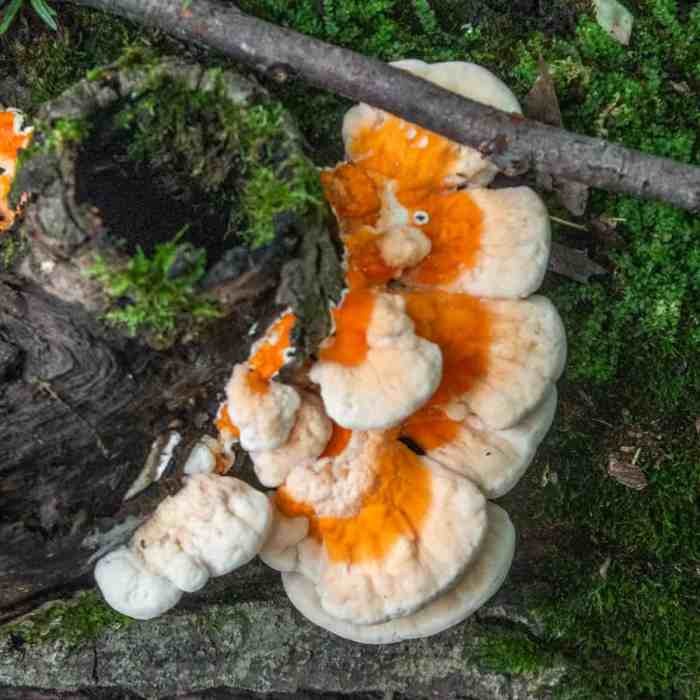
Chicken of the woods recipe, prepare to embark on a culinary adventure that will tantalize your taste buds and connect you with nature’s bounty. This vibrant fungus, with its unique appearance and versatility, offers a delectable treat that is both nutritious and satisfying.
Delve into the world of chicken of the woods, exploring its identification, nutritional value, and harvesting techniques. Discover the art of preparing this wild delicacy, from cleaning and cooking to preserving its freshness. Unleash your creativity with a variety of recipes that showcase the diverse flavors of chicken of the woods.
Chicken of the Woods Identification

Chicken of the woods, a type of polypore mushroom, is easily recognizable by its vibrant colors and unique shape. This edible mushroom is characterized by its bright orange to yellow hues and its fleshy, shelf-like appearance.
Chicken of the woods can vary in size, with some specimens reaching up to 12 inches in width and weighing several pounds. The texture of the mushroom is typically firm and meaty, making it a popular choice for culinary use.
Varieties of Chicken of the Woods
There are several varieties of chicken of the woods, each with its own unique features:
- Laetiporus sulphureus: This is the most common variety of chicken of the woods, found in North America and Europe. It is characterized by its bright orange to yellow color and its large, shelf-like shape.
- Laetiporus cinereus: Also known as the “gray chicken of the woods,” this variety is found in North America and Europe. It is typically smaller than L. sulphureusand has a grayish-brown color.
- Laetiporus conifericola: This variety is found in North America and Europe and grows on coniferous trees. It is typically smaller than L. sulphureusand has a brownish-orange color.
Habitat and Growing Conditions, Chicken of the woods recipe
Chicken of the woods is a parasitic fungus that grows on dead or dying hardwood trees, particularly oak, maple, and beech trees. It typically fruits in the late summer and fall, after periods of heavy rain. The mushroom prefers moist, shady areas and can be found in both forests and urban areas.
Nutritional Value and Health Benefits

Chicken of the woods is a nutritionally dense mushroom that offers a range of health benefits. It is a good source of protein, fiber, and various vitamins and minerals.
Protein
- Chicken of the woods is a good source of protein, containing around 10-15% of its dry weight as protein.
- This protein is rich in essential amino acids, which are necessary for various bodily functions, including muscle growth and repair.
Fiber
- Chicken of the woods is also a good source of fiber, both soluble and insoluble.
- Soluble fiber helps to lower cholesterol levels and improve blood sugar control, while insoluble fiber promotes regularity and gut health.
Vitamins and Minerals
- Chicken of the woods contains a variety of vitamins and minerals, including vitamin C, vitamin D, potassium, and iron.
- Vitamin C is an important antioxidant that helps to protect cells from damage, while vitamin D is essential for bone health.
Potential Health Benefits
- In addition to its nutritional value, chicken of the woods has been shown to have several potential health benefits, including antioxidant, anti-inflammatory, and immune-boosting effects.
- The antioxidants in chicken of the woods may help to protect against cellular damage and reduce the risk of chronic diseases such as cancer and heart disease.
Precautions
- While chicken of the woods is generally considered safe to eat, there are a few potential risks and precautions to be aware of.
- Some people may experience allergic reactions to chicken of the woods, especially if they are allergic to other types of mushrooms.
- Additionally, chicken of the woods can accumulate heavy metals from the environment, so it is important to collect mushrooms from clean, uncontaminated areas.
Harvesting and Preparation Techniques: Chicken Of The Woods Recipe
Chicken of the woods is best harvested in the late summer and early fall when it is young and tender. It can be found growing on dead or dying hardwood trees, such as oak, maple, and beech. When harvesting, use a sharp knife to cut the mushroom from the tree.
Be sure to leave the base of the mushroom intact so that it can continue to grow.
Once you have harvested the chicken of the woods, it is important to clean and prepare it for cooking. To clean the mushroom, use a damp cloth to wipe away any dirt or debris. You can also use a soft brush to remove any stubborn dirt.
Once the mushroom is clean, cut it into small pieces.
Chicken of the woods can be cooked in a variety of ways. It can be sautéed, grilled, or roasted. When sautéing, use a little bit of oil or butter to cook the mushroom until it is golden brown. When grilling, cook the mushroom over medium heat until it is cooked through.
When roasting, roast the mushroom at 400 degrees Fahrenheit for 20-30 minutes, or until it is cooked through.
Recipe Ideas and Flavor Profiles

Chicken of the woods is a versatile mushroom that can be used in a variety of dishes. It has a meaty texture and a slightly nutty flavor, which makes it a great substitute for chicken in many recipes.
Here are a few ideas for how to use chicken of the woods in your cooking:
Salads
Chicken of the woods can be added to salads for a boost of protein and flavor. It can be cooked and shredded, or sliced and grilled. Try adding it to a salad with mixed greens, tomatoes, cucumbers, and a vinaigrette dressing.
Soups and Stews
Chicken of the woods can be used to make hearty soups and stews. It can be cooked in a broth with vegetables, such as carrots, celery, and onions. Add some spices and herbs, such as thyme, rosemary, and bay leaves, for extra flavor.
Main Courses
Chicken of the woods can be used as a main course. It can be grilled, roasted, or fried. Try grilling it with some vegetables, such as peppers and onions. Or, roast it with some potatoes and carrots. You can also fry it and serve it with a dipping sauce.
Storage and Preservation Methods

Fresh chicken of the woods can be stored in the refrigerator for up to 3 days. To extend its shelf life, it can be stored in the freezer for up to 6 months.
Drying
Drying is an effective way to preserve chicken of the woods. Cut the mushroom into thin slices and place them on a baking sheet lined with parchment paper. Bake at 150°F (65°C) for several hours, or until the mushrooms are completely dry and crispy.
Dried chicken of the woods can be stored in an airtight container at room temperature for up to 6 months.
Freezing
Freezing is another option for preserving chicken of the woods. Cut the mushroom into pieces and blanch them in boiling water for 2 minutes. Drain the mushrooms and spread them on a baking sheet lined with parchment paper. Freeze the mushrooms for at least 2 hours, or until they are completely frozen.
Transfer the frozen mushrooms to an airtight container and store them in the freezer for up to 6 months.
Pickling
Pickling is a great way to preserve chicken of the woods and add a tangy flavor. Cut the mushroom into thin slices and place them in a jar. Add a pickling solution made with vinegar, water, sugar, and salt. Seal the jar and store it in the refrigerator for at least 2 weeks before eating.
Closing Notes

As you savor each bite of chicken of the woods, appreciate its journey from forest to plate. Embrace the culinary possibilities of this remarkable ingredient, experimenting with different recipes and flavor combinations. Whether enjoyed fresh, dried, or pickled, chicken of the woods offers a culinary experience that is both delicious and sustainable.
Clarifying Questions
What is the best way to identify chicken of the woods?
Look for bright orange or yellow shelf-like structures with a velvety texture. The underside should have small, white pores.
Can chicken of the woods be eaten raw?
No, it is recommended to cook chicken of the woods before consuming to ensure its digestibility and safety.
How long can chicken of the woods be stored?
Fresh chicken of the woods can be stored in the refrigerator for up to 3 days. It can also be dried or frozen for longer storage.





